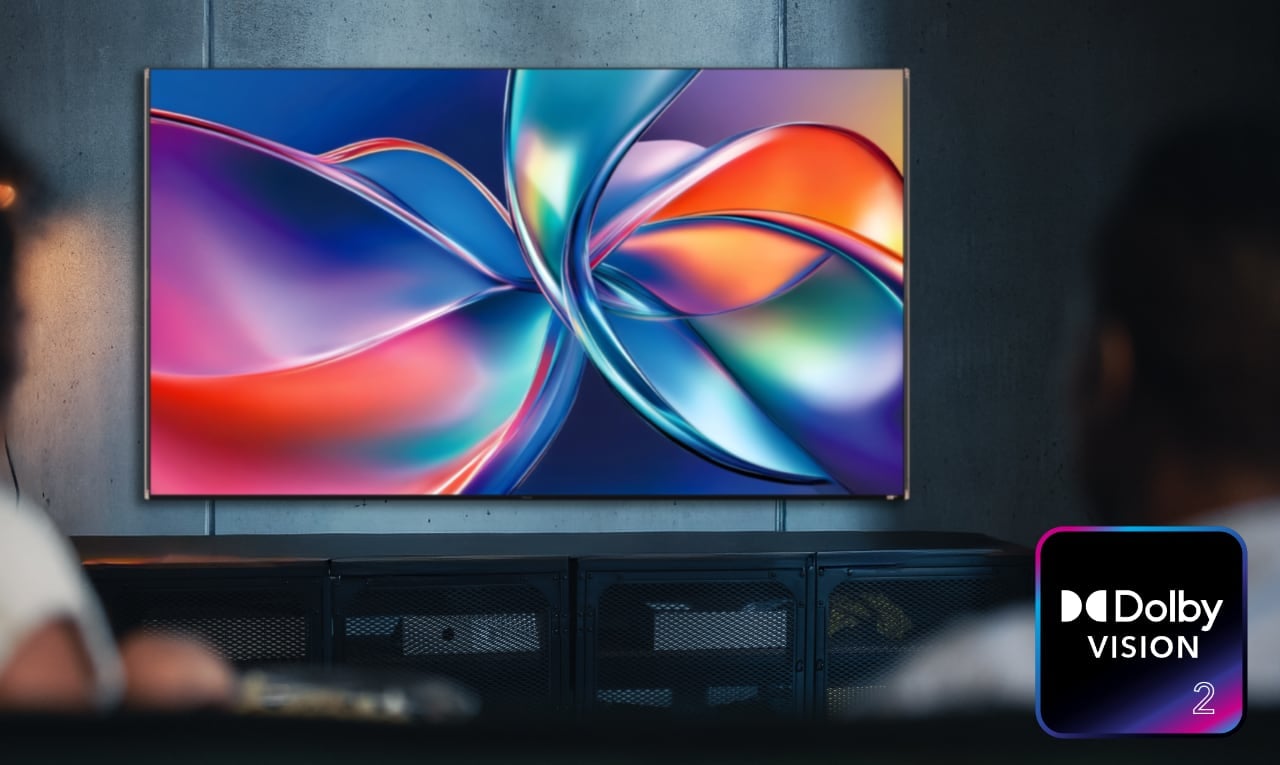Living rooms have long suffered from a persistent problem: dark movie scenes that leave viewers squinting at murky shadows, adjusting brightness settings, and missing crucial visual details. Even premium TVs with impressive specifications often fail to deliver the director’s intended vision when ambient light interferes with on-screen content. This disconnect between creative intent and home viewing reality has frustrated both filmmakers and audiences for years. The issue stems from fundamental limitations in how traditional display technologies process and adapt HDR content to real-world viewing environments.
Designers: Dolby + Hisense
That changes with the introduction of Dolby Vision 2, which debuts on the Hisense 116UX RGB Mini-LED TV. Dolby announced this breakthrough technology, positioning it as a solution…to the most common viewing complaints while maintaining artistic integrity. The 116UX becomes the first consumer television to feature this advanced HDR processing, combining Hisense’s proprietary RGB Mini-LED backlighting with Dolby’s most sophisticated image engine to date.
Advanced RGB Mini-LED Technology Meets Advanced HDR Processing
The Hisense 116UX stands apart from conventional Mini-LED displays through its use of individually controlled red, green, and blue LEDs instead of traditional white LEDs with color filters. This RGB Mini-LED approach delivers 95% coverage of the BT.2020 color space, surpassing most OLED displays in color accuracy while achieving peak brightness levels up to 10,000 nits. The massive 116-inch screen incorporates thousands of independent RGB zones that provide precise local dimming control at both the individual LED level and cluster level.
Dolby Vision 2 introduces Content Intelligence, a system that automatically optimizes picture quality based on both the content being displayed and the viewing environment. The technology addresses three critical areas that have historically challenged home viewers. Precision Black enhances clarity in dark scenes without compromising artistic intent, making shadow details visible even in bright rooms. Light Sense uses advanced ambient light detection combined with reference data from content sources to fine-tune the display for optimal viewing conditions. Sports and Gaming Optimization provides specialized enhancements including white point adjustments and motion control designed specifically for fast-moving content.
The combination creates a viewing experience that adapts intelligently to circumstances while preserving the creator’s original vision. Where traditional HDR often forces viewers to choose between accurate colors and visible detail in challenging lighting conditions, Dolby Vision 2 eliminates this compromise through bi-directional tone mapping that takes full advantage of modern display capabilities.
Authentic Motion Control Addresses Cinema Quality Concerns
Dolby Vision 2 expands beyond traditional HDR processing to include Authentic Motion, described as the world’s first creative-driven motion control tool. This technology addresses the artificial “soap opera effect” that makes cinematic content appear unnaturally smooth by preserving the director’s intended motion aesthetic while eliminating visual artifacts. The system operates on a shot-by-shot basis, ensuring that fast-paced action sequences maintain clarity without introducing unwanted smoothness that undermines the cinematic experience.
For sports content, the optimization provides enhanced color accuracy and motion clarity that keeps fast-moving action sharp and vibrant. Gaming receives similar treatment with specialized processing designed to meet the performance requirements of interactive entertainment while maintaining low input lag for competitive play.
The Hi-View AI Engine X powers these advanced processing capabilities, utilizing artificial intelligence to make real-time adjustments that optimize every frame for the specific display capabilities and viewing environment. This represents a significant advancement over static HDR implementations that apply uniform processing regardless of content type or viewing conditions.
Industry Partnership Launches Premium Display Era
Hisense partners with MediaTek to implement Dolby Vision 2 through the Pentonic 800 processor with MiraVision Pro PQ Engine, marking the first silicon chip designed specifically to integrate this advanced HDR technology. This dedicated hardware approach ensures complex processing algorithms operate without impacting overall TV performance or introducing latency that could affect gaming or interactive content.
According to Sonny Ming, GM of Hisense TV Product Marketing, “Dolby Vision 2 jointly with Hisense RGB Mini-LED Technology can deliver dramatically astonishing picture and increase the potential of TVs with ultra-wide color and ultra-high brightness, which haven’t been possible until today.” The combination addresses limitations that have prevented displays from fully utilizing their hardware capabilities, particularly in challenging viewing environments.
CANAL+ joins as the first media and entertainment group committed to supporting Dolby Vision 2 across its content lineup, from movies and TV shows to live sports. This partnership ensures viewers will have access to optimized content that takes full advantage of the new technology’s capabilities. As Stéphane Baumier, Chief Technology Officer of CANAL+, explains, “With the launch of Dolby Vision 2 across movies, series, and live sports, that experience reaches breathtaking new heights.”
Two-Tier Strategy Addresses Different Market Segments
Dolby Vision 2 launches in two configurations designed to serve different consumer segments and display capabilities. Dolby Vision 2 Max targets high-end displays like the 116UX, delivering premium features that utilize the full capabilities of advanced RGB Mini-LED technology, extreme brightness levels, and wide color gamuts. The standard Dolby Vision 2 tier brings core next-generation capabilities to mainstream TVs through the new Dolby Image Engine and Content Intelligence features.
This approach ensures that fundamental improvements in dark scene visibility and environmental adaptation reach a broader audience while allowing flagship displays to showcase the technology’s complete potential. Both tiers share the same underlying technology foundation, providing consistent quality improvements across different price points while maximizing the capabilities of modern TV hardware.
Real-World Impact: Building on Proven Excellence
The potential of Dolby Vision 2 becomes even more compelling when considering the already impressive performance of Hisense’s current large-screen offerings. Having reviewed the 100-inch Hisense U8QG for Yanko Design, the transformative power of truly large displays is evident. That 100-inch model delivered exceptional 5,000 nits peak brightness and over 5,000 local dimming zones, creating genuinely cinematic experiences that transformed both sports viewing and movie watching in challenging lighting conditions.
The U8QG’s anti-glare coating performed admirably in bright environments, minimizing reflections during daytime viewing while maintaining vibrant contrast and bold brightness. The 4.1.2-channel Dolby Atmos audio system eliminated the need for external speakers in most scenarios, creating an immersive viewing experience that held its own even in daylight conditions. These capabilities provided a foundation that demonstrates what becomes possible when display hardware reaches sufficient scale and sophistication.
With Dolby Vision 2, these already impressive large-screen experiences would reach new heights through intelligent adaptation. The Content Intelligence system would automatically optimize the display based on both content type and viewing environment, eliminating the manual adjustments often required to achieve optimal picture quality in varying lighting conditions. Where the U8QG already excelled at maintaining visibility in bright rooms, Dolby Vision 2’s Precision Black and Light Sense features would ensure that dark scene details remain crystal clear without compromising the creator’s artistic intent.
The 116UX’s RGB Mini-LED technology, combined with Dolby Vision 2’s advanced processing, addresses the fundamental challenge of delivering consistent quality across different content types and viewing scenarios. Sports content would benefit from specialized white point adjustments and motion control, while gaming would receive optimization designed specifically for interactive entertainment. The Authentic Motion feature would preserve the cinematic quality of films while eliminating the artificial smoothness that often undermines the viewing experience.
The post Hisense 116UX RGB Mini-LED TV Becomes First Consumer Display with Dolby Vision 2 Technology first appeared on Yanko Design.

